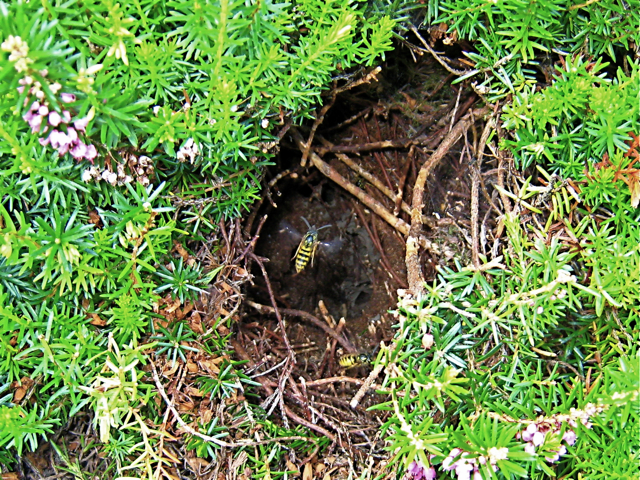Lifestyle
Eliminate areas on property favoured by wasps to reduce chances of nesting
VICTORIA—Barbecues and backyard gatherings are a summertime staple in Canada, and so are wasps, the uninvited guests with a painful sting. As the season continues, wasps become more aggressive and homeowners may begin to notice more nests around their property.
Kurtis Brown, technical supervisor at Victoria Pest Control, says while his business is dealing with between 10 and 15 wasp nests per day, it is hard to quantify whether there are more of the insects this season.
“As we approach peak summer time, and we get that nice heat wave, wasps really start to develop and nests really start to take off,” says Brown. “People are certainly noticing a few more wasps than usual.”
The most common varieties homeowners deal with are aerial yellow jackets, bald-faced hornets, paper wasps and ground yellow jackets, which make their nests in holes and crevices.
According to Brown, the aerial yellow jackets and the bald-faced hornets—which despite their name are wasps—often make their nests in trees, bushes or under decks.
“They build those big beautiful hanging nests that can be as big or bigger than a basketball,” says Brown. “The bald-faced hornets are the species that people often see and get worried about for good reason because they can be very aggressive.”
The yellow jackets that make their nests in the ground and holes can also cause serious problems for homeowners. Brown says people often don’t know they have a ground nest on their property until they disturb it.
“They are the worst of the bunch, and they are a pretty common group of wasps,” he says. “Those are the nests people should never attempt to deal with on their own. They are difficult to treat or get rid of and they are very aggressive.”
The first thing a homeowner should do if they find a wasp nest is to locate the entry point and stay clear.
“Colonies have drones and their one job is to protect the nest at all costs,” says Jarrod Warkentin, owner and manager of Spartan Pest Control in Calgary. “If a homeowner disturbs the nest or poses any threat whatsoever to the queen, they will attack in full force.”
A Quebec mayor died after stepping on a wasp nest while gardening. Lucie F. Roussel, mayor of La Prairie, died in hospital Sunday after being stung at least 15 times in the garden of her cottage near Stratford, Que., municipal authorities said.
While it is possible to treat and eliminate an aerial or paper wasp nest, Warkentin says if someone is allergic they should call a pest control company to deal with it.
If a homeowner feels up to the challenge of treating a visible nest, there are products available at hardware stores. Warkentin stresses it is important to fully read the product instructions, and to only buy a spray with a minimum 4.6-metre pin-stream.
“This will allow the homeowner to stand at maximum distance, reducing the chance of being stung,” he says.
Time of day can play an important role in successfully eliminating a nest, says Brown. Wasps are most active when the sun is up, making it advisable to spray a nest either before the sun comes up in the morning or after it has set in the evening.
Both Brown and Warkentin say there are small things that can be done to reduce the chance of wasps building a nest on or near a homeowner’s property.
Removing fallen fruit from trees along with treating exposed wood, which is used by wasps to make their nests, can reduce wasp activity.
“Sealing any holes, cracks or crevices along concrete driveways, window sills or any other hollow entry point can reduce the possibility of a ground nest,” says Warkentin. “It is also important to inspect for insect activity on a regular basis. If you find a wasp, follow it and see where it goes. The sooner the nest is found and controlled the better.”
To avoid attracting wasps to your backyard party, cover sweet drinks and proteins, which are popular attractants for wasps. Garbage cans should also be tightly sealed.
Wasp traps placed at the edge of a property can effectively capture them using pheromones. Brown says they have been known to trap hundreds of wasps in a season.






















